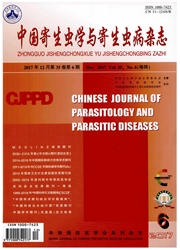

 中文摘要:
中文摘要:
目的 分析我国部分地区28种蚊虫的线粒体细胞色素c氧化酶亚基Ⅰ(mitochondrion cytochrome c oxidase subunit Ⅰ,COⅠ)基因序列,探讨其作为蚊虫分子标记的应用潜力。 方法 2015年3月至2016年10月在我国海南、广东、广西、云南、福建、浙江、河南、山西、天津、内蒙古、吉林和黑龙江等12省(自治区、直辖市)的蚊虫孳生地采集幼虫,室内饲养至羽化成蚊,在蚊虫栖息地和蚊虫监测点,采用灯诱法和人诱法采集成蚊。所有成蚊经形态学鉴定后,提取单只蚊虫基因组DNA,采用国际双翅目通用引物PCR扩增并克隆线粒体COⅠ基因5′端片段,并进行测序。所得COⅠ基因序列上传GenBank获取登录号。序列通过Clustal1.83和MEGA5.05软件进行多序列比对,用DNAMAN9.0软件分析同源性。采用Mega5.05软件进行序列特征分析、计算遗传距离。每种蚊虫随机选择1~4条线粒体COⅠ基因序列,采用邻接法(NJ)构建系统发育进化树。 结果 共采集3亚科6属28种301只蚊虫,分别为伊蚊属(Aedes)的白纹伊蚊(Ae. albopictus)等5种、按蚊属(Anopheles)的中华按蚊(An. sinensis)等6种(亚种)、库蚊属(Culex)的二带喙库蚊(Cx. bitaeniorhynchus)等14种(亚种)、阿蚊属(Armigeres)的骚扰阿蚊(Ar. subalbatus)、曼蚊属(Mansonia)的常型曼蚊(Ma. uniformis)和巨蚊属(Toxorhynchites)的华丽巨蚊(Tx. splendens)。PCR扩增结果显示,28种蚊虫线粒体COⅠ基因的长度约711 bp,经多序列比对排齐后长度为651 bp。不同种别蚊虫的线粒体COⅠ序列同源性范围为97.85%~99.97%。种内K2P遗传距离为0.15%~2.89%,属内种间遗传距离为0.25%~14.50%。其中,按蚊属6种蚊虫COⅠ序列存在153个变异位点,131个简约信息位点,T + A平均含量为67.70%;编码的217个氨基酸残基中保守氨基酸206个(占94.9%);6种蚊虫的核苷酸同源性为98.31%~99.72%?
 英文摘要:
英文摘要:
Objective To perform mitochondrial DNA sequence analysis of cytochrome oxidase subunit Ⅰ (COⅠ) gene from 28 species of mosquitoes in China and to explore the potential use of COⅠ as a molecular marker to distinguish mosquito species. Methods Mosquito larvae were collected from mosquito breeding grounds in 12 Provinces/Municipalities/Autonomous Regions including Hainan, Guangdong, Guangxi, Yunnan, Fujian, Zhejiang, Henan, Shanxi, Jilin, Heilongjiang, Tianjin and Inner Mongolia, from April 2015 to October 2016, and were grown into mosquitoes. The human trap and light trap methods were used to collect adult mosquitoes. After morphological identification, genomic DNA was extracted individually from the mosquitoes, and the 5′ fragment of mitochondrial COⅠ gene was amplified by PCR using international Diptera primers and sequenced. Alignment of multiple sequences was performed with Clustal 1.83 and MEGA 5.05 softwares. DNAMAN 9.0 software was used to calculate the identity among sequences and Mega 5.05 software was used to analyze sequence characteristics and calculate the genetic distance. The phylogenetic tree was constructed by Neighbor-Joining (NJ) method based on 1-4 sequences randomly selected for each species. Results A total of 301 mosquitoes were collected, belonging to 28 species, six genera, three subfamilies. The 28 species included 5 species of the Aedes genus, 6 species of the Anopheles genus, 14 species of the Culex genus, as well as species of Armigeres subalbatus, Mansonia uniformis, and Toxorhynchites splendens. The amplification of COⅠ gene in the 28 mosquito species produced bands of ~711 bp, but the final length of sequence for analysis after sequence alignment was 651 bp. The COⅠ sequence identity among different species ranged 97.85%-99.97%. The intraspecies and interspecies K2P genetic distances were 0.15%-2.89% and 0.25%-14.5%, respectively. There were 153 mutational sites and 131 parsimony-informative sites in the COⅠ sequence among the 6 species of the Anopheles genus
 同期刊论文项目
同期刊论文项目
 同项目期刊论文
同项目期刊论文
 期刊信息
期刊信息
